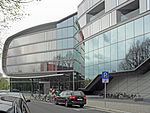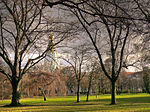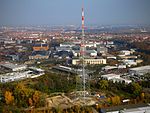German Music Archive
1970 establishments in West GermanyArchives in GermanyArts organizations established in 1970Government agencies established in 1970Music in Leipzig ... and 1 more
Sound archives

The German Music Archive (in German: Deutsches Musikarchiv, DMA) in Leipzig, is the central collection of printed and recorded music and the music-bibliographic information centre for Germany. It is a Federal agency founded in 1970, tasked with collecting all music published in the country. Publishers of printed and recorded music in Germany are required by law (since 1973) to deliver two copies of every edition as legal deposits to the archive.The DMA constitutes a department of the German National Library, Leipzig (Deutsche Nationalbibliothek).
Excerpt from the Wikipedia article German Music Archive (License: CC BY-SA 3.0, Authors, Images).German Music Archive
Deutscher Platz, Leipzig Southeast center (Mitte)
Geographical coordinates (GPS) Address Phone number Website Nearby Places Show on map
Geographical coordinates (GPS)
| Latitude | Longitude |
|---|---|
| N 51.322361111111 ° | E 12.396694444444 ° |
Address
Deutsche Nationalbibliothek
Deutscher Platz 1
04103 Leipzig, Southeast center (Mitte)
Saxony, Germany
Open on Google Maps










